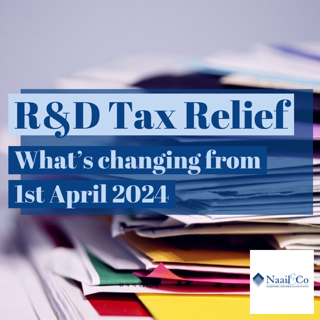R&D Tax Relief: What's changing from 1st April 2024
Let’s delve into the forthcoming alterations in the pipeline, shedding light on the intricacies of the restructured and amalgamated research and development (R&D) tax framework.
Research and development (R&D) tax relief has emerged as a significant driver of innovation within UK businesses, with HMRC reporting a record £7.6 billion in total relief claimed for the 2021-2022 tax year. However, concerns about potential abuse led to a reform consultation launched in early 2021. Following extensive technical consultations, the government announced its intention in late 2022 to merge the existing two schemes, aiming to streamline the incentive and protect it from future abuse.
The merged R&D scheme is scheduled for introduction for accounting periods beginning on or after 1 April 2024. Combining the existing SME incentive with the RDEC aimed at larger businesses, the new merged scheme has garnered mixed reactions, with clear winners and losers anticipated due to the government’s objective to ‘rebalance’ the different rates available. Accountants will continue to play a crucial role in advising their clients about the changes and assisting them in planning ahead, given the complexities of the reform and its implications for all companies accessing R&D reliefs.
Shake-up for R&D-intensive SMEs
In the aftermath of last year’s Autumn Statement, discussions primarily centered around the forthcoming merged scheme, which aimed to streamline the research and development (R&D) tax framework. However, despite this focus, two separate incentive schemes will persist, with the continuation of the enhanced rate tailored for R&D-intensive Small and Medium-sized Enterprises (SMEs), introduced in 2023, operating within the existing SME model.
Exclusive to loss-making SMEs allocating a designated proportion of their total business expenditure to R&D activities, the R&D intensive SME scheme has been pivotal in incentivizing innovation. A significant decision announced in the Autumn Statement 2023 was the reduction of the qualifying threshold for this scheme from 40% to 30% of a company’s total expenditure. Consequently, this legislative adjustment aims to broaden eligibility, allowing more loss-making SMEs to qualify as R&D intensive and gain access to enhanced financial relief, facilitating their growth and development initiatives.
Furthermore, a noteworthy addition is the introduction of a one-year grace period for companies that fall below the 30% R&D intensity threshold. This provision aims to facilitate long-term financial planning and investment decisions, mitigating instances where businesses fluctuate in and out of the R&D-intensive regime on an annual basis.
Despite the positive trajectory from the initial reduction in rates for SME relief to the recent changes to the R&D intensive SME scheme, a discernible gap persists between the government’s overarching innovation policy and its practical implementation. While the reduction of the threshold to 10% marks a commendable step, it remains a formidable benchmark. Notably, even businesses allocating a quarter of their overall expenditure to R&D may still not qualify as R&D intensive under the current scheme.
While the policy undoubtedly provides support to smaller enterprises committed to substantial R&D investment, safeguarding them from severe cuts to relief rates, there remains substantial scope for improvement, given the diverse landscape of SME R&D. Addressing these disparities is essential to ensure that the innovation ecosystem effectively nurtures and supports businesses across all sectors.
Subcontracted R&D
In the context of the merged scheme, the decision to adopt the Research and Development Expenditure Credit (RDEC) mechanism brings about significant changes that may pose challenges for existing RDEC claimants who are not adequately prepared. A technical note released subsequent to the announcement of the merged scheme underscores the intricate nature of how the incentive will address contracted out R&D activities.
The government’s emphasis on bolstering R&D investment by reducing associated costs is reiterated through the merged scheme’s objective to grant R&D relief to the decision maker within a supply chain. Additionally, the revised policy permits most companies outsourcing their R&D endeavors to claim tax relief for the associated costs, akin to the current SME scheme.
To facilitate this, the merged scheme introduces a comprehensive legislative definition of contracted out R&D, embracing a principles-based approach. While this clarification seeks to alleviate prior uncertainties in this complex domain, the magnitude of such policy changes typically yields both beneficiaries and those adversely affected.
Under current regulations, businesses conducting R&D on behalf of larger counterparts typically claim under RDEC, given the limitations faced by large companies in incorporating such costs into their R&D claims. However, under the merged scheme, these businesses will no longer be deemed the R&D decision maker and consequently unable to make a claim if their contractor can. Conversely, the larger company contractor stands to benefit from an augmented claim value.
For instance, a small company specializing in healthcare technology development may have been engaged by a larger entity to provide support in addressing specific issues. While under the current scheme, the small company may qualify as an R&D subcontractor and access relief under RDEC, the merged scheme precludes such claims, favouring the larger firm.
The ramifications of this change on R&D investment stimulation and ensuing commercial negotiations between parties impacted remain to be observed. Criticism regarding the pace of the merger’s implementation stems from the lack of modeling and consultation on its potential impact, particularly concerning this significant shift.
Additionally, 2024 heralds the removal of all restrictions on subsidised expenditure from both the merged RDEC scheme and the R&D-intensive SME scheme. Previously, companies faced restrictions on claiming tax credits for subsidized R&D expenditures, a scenario not mirrored in RDEC but contemplated in earlier proposals for the merged scheme. This removal signifies a positive stride towards simplifying the process and enhancing generosity in R&D tax credits, albeit exemplifying the intricate nature of such policy adaptations and the challenge for advisors to ensure clients receive pertinent and precise guidance.
Subsidised expenditure restrictions removed
In 2024, significant changes are anticipated with the removal of all restrictions on subsidised expenditure, applicable to both the merged Research and Development Expenditure Credit (RDEC) scheme and the Research and Development (R&D) intensive Small and Medium-sized Enterprise (SME) scheme.
Under the previous SME framework, companies undertaking R&D projects that received subsidies encountered limitations in claiming tax credits for the subsidised portion of their R&D expenditure or, in some cases, for broader project costs. While these restrictions were absent in the RDEC scheme, they were initially proposed for inclusion in the merged scheme, leading to deliberation and debate.
The elimination of these restrictions in the upcoming period signifies a significant advancement, enabling companies to claim R&D tax credits on expenditures that have been partially or fully subsidised. This shift is commendable for its enhancement of both generosity and simplicity within the tax credit system.
This development within the merged scheme exemplifies the complexities inherent in protracted consultations and underscores the challenge faced by advisors in maintaining current knowledge to ensure their clients receive precise and pertinent guidance.
The end of R&D tax reform
The legislative announcement made in the Autumn Statement marks the conclusion of the consultation period on Research and Development (R&D) tax reliefs, initiated in March 2021. This signifies a pivotal moment in the evolution of R&D tax policy.
The transition of the existing relief mechanisms into the merged scheme is expected to streamline the process, offering a simplified framework for businesses to navigate. Establishing a robust and cohesive framework moving forward is crucial for providing the long-term stability necessary for R&D tax relief policy.
However, it’s essential to acknowledge that the ramifications of these changes will be varied for different firms. Advisers must exercise diligence in understanding the nuances of the merger to effectively guide their clients through the transition.
Importantly, the conclusion of the R&D tax incentive consultation should not mark the end of productive dialogues between the government and businesses regarding the technical aspects of the scheme. Continuous engagement and communication between stakeholders are vital to maximizing the potential of the R&D tax relief incentive and ensuring the UK maintains its position as a leading global innovation hub.
In anticipation of the proposed changes slated for April 2024, accountants should remain vigilant. The forthcoming framework will undoubtedly impact eligibility criteria, the value of relief, and the claims process for businesses involved in R&D activities. Being well-versed in these adjustments will enable accountants to provide informed guidance to their clients.

Our service to you
If you are a self employed, business owner/director of company looking to get your accountancy and taxation matters sorted, look no further. We, at Naail & Co, are pro-active and easily accessible accountants and tax advisors, who will not only ensure that all your filing obligations are up to date with Companies House and HMRC, but also you do not pay a penny more in taxes than you have to. We work on a fixed fee basis and provide same day response to all your phone and email enquiries. We will also allocate a designated accounts manager who would have better understanding of your and business financial and taxation affairs. Book a free consultation call using the link below.
Related pages:
Get further information from the following pages;
Related Blogs:
Get further information from the following blogs;
R&D Tax Credits scam: HMRC arrests 8
Subscribe to our newsletter
BUSINESS HOURS
Monday – Friday
- 9:00 am – 5:30 pm
Pages:
Menu








